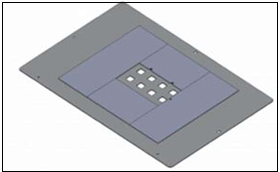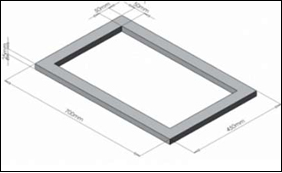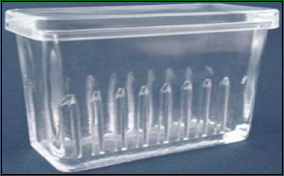Use:
Screen Printing jigs are used in DSSC to allow consistent alignment of glass substrates during the printing cycle. Screen Printing jigs are provided with the screen printers.
Description:
The Screen Printing jig are uses a three pin alignment system to ensure that the glass substrates are placed in a repeatable position on the work table. This allows for multiple substrates to be printed during the one production run.
Specifications:
| Features | Description | Benefits | |
| Jig Size (L x W x H) |
Large: 739 mm x 538 mm x 2 mm Medium: 639 mm x 438 mm x 2 mm Compact: 439 mm x 288 mm x 2 mm |
Jig sizes are matched to fit the maximum working area of each Screen Printer | |
| Blanking Plates | Blanking Plates are provided to be placed around the edges of the substrates to be printed. This reduces the wear on the screen mesh and ensures longer screen mesh life time | ||
| Substrate Size | Maximum: 180mm x 100mm Minimum: 140mm x 60mm |
Standard glass plates can be accommodated using the standard configuration | |
Use:
Laboratory Level screen are used in DSSC with the screen printers to allow printing of pastes and are provided with the screen printers.
Description:
The Lab Level Screens are provided with standard Test cell artwork so that TiO2 pastes and Pt pastes can be printed. These meshes have been carefully selected to provide the optimum layer thickness for; TiO2 pastes: 18NR-T and 18NR-AO & Pt paste: PT-1
Screens are matched to meet the frame dimensions required for Screen Printers also provides blank screens to allow custom designed application.
Specifications:
| Features | Description | Benefits |
| Frame Size | Large: 850mm(L) x 650mm(W) Frame height/width: 40mm/40mm Medium: 700mm(L) x 450mm(W) Frame height/width: 25mm/50mm Compact: 490mm(L) x 350mm(W) Frame height/width: 25mm/25mm |
Screen frame sizes are matched to fit the maximum working area of each Screen Printer |
| Screen Mesh | Working Electrode: 45T meshCounter Electrode: 100T mesh | Screen meshes are matched to standard pastes to allow for optimum layer thickness |
| Quantity | Screen mesh 45T: One frame with standard artwork for WE Test cell plates, One blank mesh screenScreen mesh 100T: One frame with standard artwork for CE Test cell strips, One blank mesh screen | Allows for printing of standard plates and strips to produce standard Test Cells.Blank screens allow for creating screens with custom artwork designs |
Test Cell Dye Tanks:
Use:
Test Cell Dyeing Tanks are used in DSSC to dye up to 8 test cell working electrodes per tank.
Description:
The Test Cell Dyeing Tanks allow for a minimum of dye solution to provide effective dye coverage for test cell sized electrodes. The glass construction of the tanks is inherently chemically inert and can accommodate a wide variety of dye solvents.
The Dyeing Tanks must be placed within a dark, dry environment (5% RH or less) for optimal dying performance. Dye solution cannot be stored for extended periods within these tanks. The Test Cell Dye Tanks offer a low-cost, simple and effective solution for dyeing test cell electrodes.
Specifications:
| Features | Description | Benefits |
| Robust Material | Chemically inert glass construction | Ensures no contamination of dye solution from the tank |
| Capacity | Maximum dye solution capacity ~157.5ml | Minimizes use of dye material for smaller scale test cell electrode work but allows for adequate volume of dye coverage over DSC electrodes. |
| Test Cell Electrode Size | Accommodates test cell working electrodes sized: 23-25mm(W) x 20-50 mm(L) x 2.2-3.2mm(H) | Accommodates Dyesol standard working electrodes for test cells |



